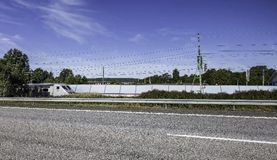Innovative noise barriers in urban development; a novel application for solar panels
The Noisun project is an effort to reduce noise from road and rail traffic in the city center of Lerum in Sweden, including demonstrating the use of solar panels as noise barriers. Integrating solar collectors in noise barriers decreases noise levels, whilst providing solar energy for the local district heating network.

The challenge
Roads and railways passing through or close to communities cause noise pollution, impacting quality of life and potentially even health. Developing and demonstrating innovative barriers to protect the urban population from noise is becoming increasingly important. Innovative noise barriers can not only reduce traffic noise, but also provide other benefits, such as producing energy.
The innovation
The project Noisun, which implemented new noise barriers in the municipality of Lerum (Sweden), has been focused on integrating energy production with solar panels integrated in noise barriers. The aim is to decrease noise and at the same time produce renewable energy, in this case solar power.
Noisun is a collaboration project between Lerum Municipality, the Swedish Transport Agency, SP Technical Research institute of Sweden, and Lerum Fjärrvärme AB. The project is also part of the European Union’s environmental programme LIFE+ and has received a grant of 5 million SEK (€545 000) (public grant partial funding for R&D). In September 2014, the total cost of the project had reached 23 million SEK (€2,5 million).
The noise protection to be built is 400 meters long and 2.5 meters high with a theoretical production estimated to 400,000 kWh of solar energy annually. Approximately 200 000 Kwh will be fed into the district heating network on an annual basis. The project facility is primarily a noise barrier and is expected to reduce noise levels in the area by 60-90%. The angle of the noise barriers will be adjusted to allow for most effective noise reduction levels.
By integrating solar panels in the noise barriers the municipality will be able to produce energy for the local district heating network. The area selected for the new noise barrier is located in the center of Lerum, close to major rail and road arteries. Property and people in this area are currently exposed to noise levels above the guideline value of 55dB.
The noise barriers and solar panels must be resistant to wind from passing trains. Stone chipping from roads will not be a problem as the closest road is at a distance. Studies have been done to determine the most suited glass types, and to determine the solar panel and barrier joints with most effective sound insulating properties.
Solar collectors on the noise barrier will be visible from the highway and railway, but from the housing area, the construction will be dressed in a tight trellis of wooden slats of untreated larch tree. The trellis will create privacy and give a uniform appearance to the surrounding area.
Why did it work?
The project Noisun started in 2009 as an effort to reduce noise from road and rail traffic in urban centers in the EU. In June 2014, work began on the installation of barriers, with construction expected to be completed by the end of the year.
The project is a partnership collaboration between various actors, each possessing important knowledge and expertise.
Further deployment
Noisun project is estimated to be 7 on the TRL scale. The solar collectors on the noise protection are expected to start to produce solar energy in the spring of 2015. Evaluation and potential for scaling up will be done shortly after.
Links:
The website